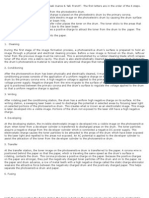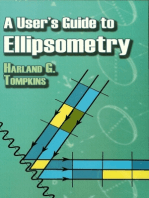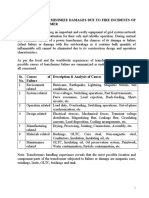Dan A. Hays, A Senior Fellow at The Xerox Corporation's Wilson Center For Research and Technology, Explains
Dan A. Hays, A Senior Fellow at The Xerox Corporation's Wilson Center For Research and Technology, Explains
Uploaded by
prakxajOriginal Description:
Original Title
Copyright
Available Formats
Share this document
Did you find this document useful?
Is this content inappropriate?
Report this DocumentCopyright:
Available Formats
Dan A. Hays, A Senior Fellow at The Xerox Corporation's Wilson Center For Research and Technology, Explains
Dan A. Hays, A Senior Fellow at The Xerox Corporation's Wilson Center For Research and Technology, Explains
Uploaded by
prakxajCopyright:
Available Formats
Dan A. Hays, a senior fellow at the Xerox Corporation's Wilson Center for Research and Technology, explains.
The xerographic process, which was invented by Chester Carlson in 1938 and developed and commercialized by the Xerox Corporation, is widely used to produce high-quality text and graphic images on paper. Because Xerox marketed the first plain-paper copiers, photocopying machines made by other companies are sometimes referred to as "Xerox machines" by those who dont realize its a misuse of the companys trademark. In addition, the xerographic process is actually used to make both copies and prints. Carlson originally called the process electrophotography. Its based on two natural phenomena: that materials of opposite electrical charges attract and that some materials become better conductors of electricity when exposed to light. Carlson invented a six-step process to transfer an image from one surface to another using these phenomena. First, a photoconductive surface is given a positive electrical charge. The photoconductive surface is then exposed to the image of a document. Because the illuminated sections (the non-image areas) become more conductive, the charge dissipates in the exposed areas. Negatively charged powder spread over the surface adheres through electrostatic attraction to the positively charged image areas. A piece of paper is placed over the powder image and then given a positive charge. The negatively charged powder is attracted to the paper as it is separated from the photoconductor. Finally, heat fuses the powder image to the paper, producing a copy of the original image. Carlsons first image, produced on October 22, 1938, was created with negatively charged yellowish moss spores (lycopodium) on a sulfur-coated zinc plate that had been positively charged by rubbing it with a handkerchief. Todays copiers and printers have automated and refined all the steps, moving paper at speeds of more than 250 feet a minute, digitally creating and exposing images, and producing images in a rainbow of colors. Heres how the process works today:
Charge. Inside every copier and laser printer is a light-sensitive surface called a photoreceptor. It consists of a thin layer of photoconductive material that is applied to a flexible belt or drum. The photoreceptor is insulating in the dark, but becomes conducting when it is exposed to light. It is charged in the dark by applying a high DC voltage to adjacent wires, which produces an intense electric field near the wires that causes the air molecules to ionize. Ions of the same polarity as the voltage on the wires deposit on the photoreceptor's surface, creating an electric field across it.
Expose. In a digital copier or printer, the image is exposed on the photoreceptor with a scanning modulated laser or a light-emitting-diode image bar. In older analog copiers, reflected light from an illuminated image is projected onto the photoreceptor. In either case, the areas of the photoreceptor exposed to light are selectively discharged, causing a reduction in the electric field. The darker areas retain their charge.
Develop. Pigmented powder used to develop the image is called toner. Toner particles made of colorant and plastic resin have precisely controlled electrostatic properties and range from about five to 10 micrometers in diameter. They are mixed with and charged by magnetized carrier beads that transport them to the development zone. The particles are charged by the phenomenon of triboelectricity (often referred to as static electricity). The electric field associated with the charge pattern of the image on the photoreceptor exerts an electrostatic force on the charged toner, which adheres to the image. A color document is formed by a printer with four separate xerographic units that create and develop separate cyan, magenta, yellow and black images. The superposition of these powder images produces full-color documents.
Transfer. The powder image is transferred from the photoreceptor onto paper by bringing the paper in contact with the toner and then applying a charge with polarity opposite to that of the toner. The charge must be strong enough to overcome the powders adhesion to the photoreceptor. A second precisely controlled charge releases the paper, now containing the image, from the photoreceptor.
Fuse. In the fusing process, the toner comprising the image is melted and bonded to the paper. This is accomplished by passing the paper through a pair of rollers. A heated roll melts the toner, which is fused to the paper with the aid of pressure from the second roll.
Clean. Toner transfer from the photoreceptor to the paper is not 100 percent efficient, and residual toner must be removed from the photoreceptor before the next print cycle. Most medium- and high-speed copiers and printers accomplish this with a rotating brush cleaner.
Xerography is a unique process that depends on chemical, electrical, mechanical and software know-how. The rapid and economical digital printing process easily produces either one print or hundreds of identical prints in black and white or color. More importantly, the capability of page-to-page variable imaging with xerography enables on-demand printing of complete documents such as brochures and books. Such on-demand printing can save time, reduce cost, and eliminate document obsolescence, overruns and warehousing.
You might also like
- 197 Tech Report - Laser Printers VsDocument42 pages197 Tech Report - Laser Printers Vsapi-3711313100% (1)
- Xer OgraphyDocument5 pagesXer OgraphyPaula ZorziNo ratings yet
- Xerography Step by StepDocument3 pagesXerography Step by StepPuskar Shigdel100% (1)
- Atta PrinterDocument7 pagesAtta PrinterAtta RandhawaNo ratings yet
- HV ApplicationsDocument1 pageHV Applicationskumarreddy247No ratings yet
- Laser Printer WorkingDocument2 pagesLaser Printer WorkingIshu AgrawalNo ratings yet
- Applications of ElectrostaticsDocument5 pagesApplications of ElectrostaticsARe-may PudeanNo ratings yet
- Physics H/W The Principle of PhotocopierDocument10 pagesPhysics H/W The Principle of PhotocopierEzequiel AnibalNo ratings yet
- Know About The Printing Technology: Laser Printers InkjetDocument7 pagesKnow About The Printing Technology: Laser Printers InkjetLalit yadavNo ratings yet
- Laser Printer 6 StepsDocument2 pagesLaser Printer 6 StepsMoe B. Us100% (6)
- PHY1004 Physics II: Dr. Suchitra RajputDocument33 pagesPHY1004 Physics II: Dr. Suchitra RajputVictor SenpaiNo ratings yet
- Laser PrinterDocument9 pagesLaser PrinterSharmain Qu100% (1)
- Photo Copiers - A StudyDocument5 pagesPhoto Copiers - A StudySenthil KumarNo ratings yet
- Laser Printers: Electrostatic ApplicationDocument2 pagesLaser Printers: Electrostatic ApplicationRawn HenryNo ratings yet
- Understanding Working Principles Laser Printer: Click To Edit Master Subtitle StyleDocument13 pagesUnderstanding Working Principles Laser Printer: Click To Edit Master Subtitle StyleJucia ChawNo ratings yet
- How Photocopiers Work by NafeesDocument47 pagesHow Photocopiers Work by NafeesnafeesNo ratings yet
- Photo CopierDocument35 pagesPhoto Copiersunil chauhanNo ratings yet
- Document 1Document14 pagesDocument 1Rakibul Hasan ArjuNo ratings yet
- Training For Basic Principles of 0ffice Equipment 1234Document72 pagesTraining For Basic Principles of 0ffice Equipment 1234dine62611No ratings yet
- ElectrostaticsDocument4 pagesElectrostaticsadamarpaganNo ratings yet
- Uses of Static Electricity PresentationDocument10 pagesUses of Static Electricity PresentationStefan MarkovicNo ratings yet
- PSG College of Technology: Department of Computer Science and EngineeringDocument11 pagesPSG College of Technology: Department of Computer Science and EngineeringkamalasrigobicaaNo ratings yet
- Lect 5Document3 pagesLect 5GPC Talwara CSENo ratings yet
- Forenic Examination of Printed DocumentDocument14 pagesForenic Examination of Printed DocumentJanaki Cheluvaraju MudaliarNo ratings yet
- Components of PhotocopierDocument1 pageComponents of PhotocopierJadyn De LeonNo ratings yet
- How Laser Printers WorkDocument1 pageHow Laser Printers WorkshreemadaviNo ratings yet
- Static ElectricityDocument4 pagesStatic Electricityاسامه المقطريNo ratings yet
- How Photocopiers Work: The BasicsDocument3 pagesHow Photocopiers Work: The BasicsSandip GumtyaNo ratings yet
- Applications of Electrostatics: Brandon Hall 6-2ADocument5 pagesApplications of Electrostatics: Brandon Hall 6-2ABrandon HallNo ratings yet
- Chapter IDocument17 pagesChapter IAmutha ArunNo ratings yet
- 3rd Chapter Notes Computer ScienceDocument7 pages3rd Chapter Notes Computer ScienceRAGHU RAM SAKAMURINo ratings yet
- Essay On Xerography (Laser Printer)Document3 pagesEssay On Xerography (Laser Printer)mathvin thummalaNo ratings yet
- In The Name of Allah The Most Marcifull and The BenificantDocument30 pagesIn The Name of Allah The Most Marcifull and The BenificantmrchowdharyNo ratings yet
- Dec. 18: Final Grades : (Additional Office Hours - Web Page)Document31 pagesDec. 18: Final Grades : (Additional Office Hours - Web Page)Jackelyn BautistaNo ratings yet
- Application of ElectrostaticDocument15 pagesApplication of ElectrostaticAhmadNo ratings yet
- CC 4Document14 pagesCC 4sumitNo ratings yet
- Working of Output DevicesDocument4 pagesWorking of Output DevicesZainabNo ratings yet
- Script Science PresentationDocument3 pagesScript Science Presentationdillon.purewalNo ratings yet
- Physics 1 Research Paper XEROX MACHINEDocument4 pagesPhysics 1 Research Paper XEROX MACHINECorazon GerodiasNo ratings yet
- How Laser Printers WorkDocument7 pagesHow Laser Printers WorkPradeepNo ratings yet
- The Term Computer Graphics Has Several MeaningsDocument90 pagesThe Term Computer Graphics Has Several MeaningsNihilNo ratings yet
- Dot Matrix PrinterDocument7 pagesDot Matrix Printerthecoolshubh007No ratings yet
- Computedradiography 190411130133Document22 pagesComputedradiography 190411130133Rohit nikamNo ratings yet
- E Paper ReportDocument17 pagesE Paper ReportPrakanti_TewariNo ratings yet
- 1 Practical Applications of Electromagnetism PDFDocument10 pages1 Practical Applications of Electromagnetism PDFChunesh BhallaNo ratings yet
- Electronic InkDocument28 pagesElectronic InkVisesh RoyNo ratings yet
- CH 3 HardwareDocument33 pagesCH 3 HardwareNazneen KhursheedNo ratings yet
- Laser Printer2Document21 pagesLaser Printer2lovleshrubyNo ratings yet
- SimpleTips - What Is A Printer DrumDocument2 pagesSimpleTips - What Is A Printer DrumkrishnabrNo ratings yet
- Xer OgraphyDocument10 pagesXer OgraphyAftab AhmadNo ratings yet
- Electro Beam Lithography and X Ray LithographyDocument4 pagesElectro Beam Lithography and X Ray LithographyRia Rushin JosephNo ratings yet
- Intro To CCDS: Neldel Rule (MNR) - The MNR Is An Empirical Law Known Since 1937. It States That TheDocument4 pagesIntro To CCDS: Neldel Rule (MNR) - The MNR Is An Empirical Law Known Since 1937. It States That TheArvind RajputNo ratings yet
- Laser and LED PrintersDocument55 pagesLaser and LED PrintersDrift GeeNo ratings yet
- Computedradiography 190411130133Document32 pagesComputedradiography 190411130133Raut VikramNo ratings yet
- Cathode Ray TubeDocument13 pagesCathode Ray Tubehema eswaramoorthyNo ratings yet
- E-Paper TechnologyDocument3 pagesE-Paper TechnologysoumyaNo ratings yet
- How Laser Printers WorkDocument5 pagesHow Laser Printers WorkBasharat Ali100% (1)
- Mastering Photoelectric Devices: Equipment, Theory, and ApplicationsFrom EverandMastering Photoelectric Devices: Equipment, Theory, and ApplicationsNo ratings yet
- Speed Control of DC MotorDocument18 pagesSpeed Control of DC Motorkrishnareddy_chintalaNo ratings yet
- Datasheet WFS3-40P415 6043919 enDocument7 pagesDatasheet WFS3-40P415 6043919 enДмитрий ПолухинNo ratings yet
- Tutorial 1Document1 pageTutorial 1Ashutosh TomarNo ratings yet
- SOP MAINTENANCE FINAL - Part4Document50 pagesSOP MAINTENANCE FINAL - Part4Arslan AhmadNo ratings yet
- Section 55 - Electrical System - Chapter 3Document56 pagesSection 55 - Electrical System - Chapter 3احمد الشبراوى الشبراوىNo ratings yet
- Buc Fet 11314LDocument2 pagesBuc Fet 11314LAltab HussainNo ratings yet
- Jurnal SpektrumDocument17 pagesJurnal SpektrumOdilia Yanni Mariyanti Wawo Mariyanti WawoNo ratings yet
- Describing Magnetic FieldsDocument19 pagesDescribing Magnetic FieldsFabio LayneNo ratings yet
- Industrial Instrumentation: Strain GaugesDocument58 pagesIndustrial Instrumentation: Strain GaugesBhavik PrajapatiNo ratings yet
- HHHDocument7 pagesHHHRodrigo BabijisNo ratings yet
- Precision Opacity Sensor User's Manual: June 2000 Part No. 46022300Document59 pagesPrecision Opacity Sensor User's Manual: June 2000 Part No. 46022300Jonathan Alcántara JiménezNo ratings yet
- Section 5Document67 pagesSection 5Rafael EquihuaNo ratings yet
- Magnetic RefrigerationDocument20 pagesMagnetic RefrigerationVineet DubeyNo ratings yet
- Tahir Tanoli House # 891 ST #34, Sector D/2 Hijrat Colony, Boat Basin, Karachi Cellular Number: +92-334-7345657 Career ObjectiveDocument2 pagesTahir Tanoli House # 891 ST #34, Sector D/2 Hijrat Colony, Boat Basin, Karachi Cellular Number: +92-334-7345657 Career Objectivetahir tanoliNo ratings yet
- TDK Lambda ZWS150AF 12 Datasheet PDFDocument3 pagesTDK Lambda ZWS150AF 12 Datasheet PDFHuongNo ratings yet
- 03 Physics (CH # 14+15) (10-02-2016)Document2 pages03 Physics (CH # 14+15) (10-02-2016)Anwaar Ul HaqNo ratings yet
- Circuit Wizard - MOSFET SensorDocument1 pageCircuit Wizard - MOSFET Sensorares_5555No ratings yet
- Ford Orion Electrical Wiring Diagrams in EnglishDocument3 pagesFord Orion Electrical Wiring Diagrams in Englishiva100% (63)
- GATE EE 2003 With SolutionsDocument72 pagesGATE EE 2003 With SolutionsUmar IftikharNo ratings yet
- DENSO Spark Plugs Motorcycles 2021 WebDocument134 pagesDENSO Spark Plugs Motorcycles 2021 WebAndrea PanevNo ratings yet
- Effects of Altitude On The Flashover Voltage of Contaminated InsulatorDocument4 pagesEffects of Altitude On The Flashover Voltage of Contaminated InsulatorMilton CuscoNo ratings yet
- w10g - Passivated Bridge RectifierDocument3 pagesw10g - Passivated Bridge Rectifierrudey18No ratings yet
- Holiday TestDocument2 pagesHoliday Testmohdrafeek83No ratings yet
- TVL CSS12-Q4-M5Document15 pagesTVL CSS12-Q4-M5charleneNo ratings yet
- DC Gene MCQDocument12 pagesDC Gene MCQPanneer SelvamNo ratings yet
- E E 417/517/510 Electromagnetic Radiation, Antennas, and PropagationDocument20 pagesE E 417/517/510 Electromagnetic Radiation, Antennas, and PropagationAvatarOfWoe 903No ratings yet
- Alpha Particle ScatteringDocument15 pagesAlpha Particle Scatteringadnavi95No ratings yet
- How To Build A 12 VDC To 220 VAC Power Inverter (UPS)Document14 pagesHow To Build A 12 VDC To 220 VAC Power Inverter (UPS)morfy seasNo ratings yet
- EC1 Lab Exp3 PDFDocument2 pagesEC1 Lab Exp3 PDFRitu RoyNo ratings yet
- HF25 User's Manual 990-371Document174 pagesHF25 User's Manual 990-371Bernie WireNo ratings yet

























































































